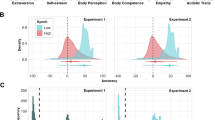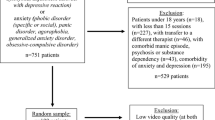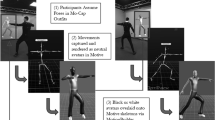Abstract
The significance of the body-mind link and the contribution of nonverbal communication in the context of psychotherapy is enjoying increased interest. Yet, the main measurements used in psychotherapy studies rely mostly on verbal measures, missing other channels of communication that would allow rich and implicit, nonverbal information. The present study is a first step toward using the mirror game (MG) as a standardized mimicry task that involves the assessment of movement synchrony as a nonverbal outcome measure for psychotherapy research. The aims of the study were twofold: (a) to investigate the possibility of automated analysis of synchrony in the MG, detecting the different roles of leadership in the game, and (b) to validate the synchrony quantified by computer algorithms with a human-rated prosocial scale. All participants (N = 33) played the MG with a gender-matched expert player. Body motions of interacting pairs were assessed using motion energy analysis. Frequency of movement synchrony was computed by windowed cross-lagged correlation and a peak-picking algorithm. Independent observers rated items with respect to prosocial parameters, using the MG scales. The algorithm allowed to differentiate quite accurately between the various roles of leadership. Significant correlations were found between the MG human-rated scales and computer-detected synchrony. High frequency of synchronized movements was linked with high levels of having fun, shared affect, and reference to the other, and with low negative affect. The MG provides a standardized and flexible paradigm for the investigation of movement synchrony. The use of both automated detection and human rating reveals the potential application of the MR in research and clinical use.


Similar content being viewed by others
Notes
“Frame-differencing method“is a technical term in computer vision science. It means that two subsequent video frames are analysed. In the case of MEA: the number of pixels whose color intensity changed from t to t + 1 is counted.
“Grey intensity“is a technical term of computer vision science. A video consists of an ordered series of frames. A frame is a digital picture that consists of pixel. In a color video, a pixel consists of the intensity of red, blue and green. In black and white videos, the pixel consists only the grey intensity. Moreover, in a color video, we can convert the intensity of red, blue, and green into one grey value. This is done in MEA.
References
Altmann, U. (2011). Investigation of movement synchrony using windowed crosslagged regression. In A. Esposito, A. Vinciarelli, K. Vicsi, C. Pelachaud, & A. Nijholt (Eds.), Analysis of verbal and nonverbal communication and enactment: The processing issue (pp. 344–354). Berlin: Springer. https://doi.org/10.1007/978-3-642-25775-9_31.
Altmann, U. (2013). Synchronisation nonverbalen Verhaltens: Weiterentwicklung und Anwendung zeitreihenanalytischer Identifikationsverfahren. [Synchronization of nonverbal behavior: Development and Application of time series analysis methods]. Berlin: Springer.
Altmann, U., Schoenherr, D., Paulick, J., Deisenhofer, A. K., Schwartz, B., Rubel, J. A., & Strauss, B. (2019). Associations between movement synchrony and outcome in patients with social anxiety disorder: Evidence for treatment specific effects. Psychotherapy Research, 1–17.
Bente, G., Donaghy, W. C., & Suwelack, D. (1998). Sex differences in body movement and visual attention: An integrated analysis of movement and gaze in mixed-sex dyads. Journal of Nonverbal Behavior, 22(1), 31–58.
Berliner, P. F. (2009). Thinking in jazz: The infinite art of improvisation. Chicago: University of Chicago Press.
Bernieri, F. J., Reznick, J. S., & Rosenthal, R. (1988). Synchrony, pseudosynchrony, and dissynchrony: Measuring the entrainment process in mother-infant interactions. Journal of Personality and Social Psychology, 54(2), 243–253.
Boal, A. (2013). The rainbow of desire: The Boal method of theatre and therapy. Abingdon: Routledge.
Boker, S. M., Rotondo, J. L., Xu, M., & King, K. (2002). Windowed cross-correlation and peak picking for the analysis of variability in the association between behavioral time series. Psychological Methods, 7(3), 338–355. https://doi.org/10.1037/1082-989x.7.3.338.
Chartrand, T. L., & Bargh, J. A. (1999). The chameleon effect: The perception–behavior link and social interaction. Journal of Personality and Social Psychology, 76(6), 893.
Cohen, J. (1988). Statistical power analysis for the behavioral sciences (2nd ed.). Hillsdale: Erlbaum Associates.
Cohen, J. (1992). A power primer. Psychological Bulletin, 112(1), 155.
Feldman, R. (2007). Parent–infant synchrony and the construction of shared timing; physiological precursors, developmental outcomes, and risk conditions. Journal of Child Psychology and Psychiatry, 48(3–4), 329–354.
Feniger-Schaal, R., Hart, Y., Lotan, N., Koren-Karie, N., & Noy, L. (2018). The body speaks: Using the mirror game to link attachment and non-verbal behavior. Frontiers in Psychology, 9, 1560.
Feniger-Schaal, R., & Lotan, N. (2017). The embodiment of attachment: Directional and shaping movements in adults’ mirror game. The Arts in Psychotherapy, 53, 55–63.
Ramseyer, F., & Tschacher, W. (2010). Nonverbal synchrony or random coincidence? How to tell the difference. In C. N. A. Esposito, C. Vogel, A. Hussain, & A. Nijholt (Eds.), Development of multimodal interfaces: Active listening and synchrony (Vol. 5967, pp. 182–196). Berlin: Springer.
Gaggioli, A., Falletta, E. M., Ferrise, F., Graziosi, S., Gallace, A., D’Ausilio, A., et al. (2019). Effects of interpersonal sensorimotor synchronization on dyadic creativity: Gender matters. Frontiers in psychology, 9, 2604.
Gaziv, G., Noy, L., Liron, Y., & Alon, U. (2017). A reduced-dimensionality approach to uncovering dyadic modes of body motion in conversations. PLoS ONE, 12(1), e0170786.
Grammer, K., Honda, M., Juette, A., & Schmitt, A. (1999). Fuzziness of nonverbal courtship communication unblurred by motion energy detection. Journal of Personality and Social Psychology, 77(3), 487–508. https://doi.org/10.1037/0022-3514.77.3.487.
Gueugnon, M., Salesse, R. N., Coste, A., Zhao, Z., Bardy, B. G., & Marin, L. (2016). The acquisition of socio-motor improvisation in the mirror game. Human Movement Science, 46, 117–128.
Harrigan, J., Rosenthal, R., Scherer, K. R., & Scherer, K. (Eds.). (2008). New handbook of methods in nonverbal behavior research. Oxford: Oxford University Press.
Harrist, A. W., Pettit, G. S., Dodge, K. A., & Bates, J. E. (1994). Dyadic synchrony in mother-child interaction: Relation with children’s subsequent kindergarten adjustment. Family Relations, 417–424.
Hart, Y., Noy, L., Feniger-Schaal, R., Mayo, A. E., & Alon, U. (2014a). Individuality and togetherness in joint improvised motion. PLoS ONE, 9, e87213. https://doi.org/10.1371/journal.pone.0087213.
Hart, Y., Noy, L., Feniger-Schaal, R., Mayo, A. E., & Alon, U. (2014b). Individuality and togetherness in joint improvised motion. PLoS ONE, 9(2), e87213.
Himberg, T., Laroche, J., Bigé, R., Buchkowski, M., & Bachrach, A. (2018). Coordinated interpersonal behavior in collective dance improvisation: The aesthetics of kinaesthetic togetherness. Behavioral sciences, 8(2), 23. https://doi.org/10.3390/bs8020023.
Hove, M. J., & Risen, J. L. (2009). It’s all in the timing: Interpersonal synchrony increases affiliation. Social Cognition, 27(6), 949–960.
Isabella, R. A., & Belsky, J. (1991). Interactional synchrony and the origins of infant-mother attachment: A replication study. Child Development, 62(2), 373–384.
Julien, D., Brault, M., Chartrand, É., & Bégin, J. (2000). Immediacy behaviours and synchrony in satisfied and dissatisfied couples. Canadian Journal of Behavioural Science/Revue canadienne des sciences du comportement, 32(2), 84.
Koole, S. L., & Tschacher, W. (2016). Synchrony in psychotherapy: A review and an integrative framework for the therapeutic alliance. Frontiers in Psychology, 7, 862. https://doi.org/10.3389/fpsyg.2016.00862.
Kreyenbrink, I., Joraschky, P., Konstantinidis, I., Neumann, N., & Lausberg, H. (2017). Nonverbales Verhalten von Patienten mit sozialen Phobien und ihren Therapeuten in psychodynamischen Psychotherapien (Teilprojekt SOPHO-NET). Zeitschrift für Psychosomatische Medizin und Psychotherapie, 63(3), 297–313.
Lakin, J. L., Jefferis, V. E., Rebing, C. M., & Chartrand, T. L. (2003). The chameleon effect as social glue: Evidence for the evolutionary significance of nonconscious mimicry. Journal of Nonverbal Behavior, 27(3), 145–162.
Leander, N. P., Chartrand, T. L., & Bargh, J. A. (2012). You give me the chills: Embodied reactions to inappropriate amounts of behavioral mimicry. Psychological Science, 23(7), 772–779.
Lindsey, E. W., Colwell, M. J., Frabutt, J. M., Chambers, J. C., & MacKinnon-Lewis, C. (2008). Mother-child dyadic synchrony in European American and African American families during early adolescence: Relations with self-esteem and prosocial behavior. Merrill-Palmer Quarterly, 54(3), 289–315.
Lindsey, E. W., Cremeens, P. R., & Caldera, Y. M. (2010). Mother–child and father–child mutuality in two contexts: Consequences for young children’s peer relationships. Infant and Child Development, 19(2), 142–160.
Lindsey, E. W., Cremeens, P. R., Colwell, M. J., & Caldera, Y. M. (2009). The structure of parent–child dyadic synchrony in toddlerhood and children’s communication competence and Self-control. Social Development, 18(2), 375–396.
McDowall, J. J. (1978). Interactional synchrony: A reappraisal. Journal of Personality and Social Psychology, 36(9), 963–975.
McGarry, L. M., & Russo, F. A. (2011). Mirroring in dance/movement therapy: Potential mechanisms behind empathy enhancement. The Arts in Psychotherapy, 38(3), 178–184.
Mogan, R., Fischer, R., & Bulbulia, J. A. (2017). To be in synchrony or not? A meta-analysis of synchrony’s effects on behavior, perception, cognition and affect. Journal of Experimental Social Psychology, 72, 13–20.
Noy, L., Dekel, E., & Alon, U. (2011). The mirror game as a paradigm for studying the dynamics of two people improvising motion together. Proceedings of the National Academy of Sciences, 108(52), 20947–20952.
Noy, L., Levit-Binun, N., & Golland, Y. (2015). Being in the zone: physiological markers of togetherness in joint improvisation. Frontiers in Human Neuroscience, 9, 187.
Paulick, J., Deisenhofer, A.-K., Ramseyer, F., Tschacher, W., Boyle, K., Rubel, J., et al. (2018a). Nonverbal synchrony: A new approach to better understand psychotherapeutic processes and drop-out. Journal of Psychotherapy Integration, 28(3), 367–384. https://doi.org/10.1037/int0000099.
Paulick, J., Rubel, J. A., Deisenhofer, A. K., Schwartz, B., Thielemann, D., Altmann, U., et al. (2018b). Diagnostic features of nonverbal synchrony in psychotherapy: Comparing depression and anxiety. Cognitive Therapy and Research, 42(5), 539–551.
Paxton, A., & Dale, R. (2013). Argument disrupts interpersonal synchrony. The Quarterly Journal of Experimental Psychology, 66(11), 2092–2102. https://doi.org/10.1080/17470218.2013.853089.
Rabinowitch, T. C., & Meltzoff, A. N. (2017). Synchronized movement experience enhances peer cooperation in preschool children. Journal of Experimental Child Psychology, 160, 21–32.
Ramseyer, F., & Tschacher, W. (2011). Nonverbal synchrony in psychotherapy: Coordinated body movement reflects relationship quality and outcome. Journal of Consulting and Clinical Psychology, 79(3), 284–295. https://doi.org/10.1037/a0023419.
Reddish, P., Fischer, R., & Bulbulia, J. (2013). Let’s dance together: Synchrony, shared intentionality and cooperation. PLoS ONE, 8(8), e71182. https://doi.org/10.1371/journal.pone.0071182.
Rennung, M., & Göritz, A. S. (2016). Prosocial consequences of interpersonal synchrony. Zeitschrift für Psychologie, 224(3), 168–189.
Repp, B. H. (2005). Sensorimotor synchronization: A review of the tapping literature. Psychonomic Bulletin & Review, 12(6), 969–992.
Schechner, R. (1994). Environmental theater. Wisconsin: Hal Leonard Corporation.
Schoenherr, D., Paulick, J., Strauss, B. M., Deisenhofer, A. K., Schwartz, B., Rubel, J. A., et al. (2019a). Identification of movement synchrony: Validation of windowed cross-lagged correlation and-regression with peak-picking algorithm. PLoS ONE, 14(2), e0211494.
Schoenherr, D., Paulick, J., Strauss, B., Deisenhofer, A.-K., Schwartz, B., Rubel, J., Altmann, U. (2019b). Nonverbal synchrony predicts premature termination of psychotherapy for social phobic patients. Psychotherapy (Chicago, III.), Advance online publication. https://doi.org/10.1037/pst0000216.
Seham, A. E. (2001). Whose improv is it anyway? Beyond Second City. Mississippi: Univ. Press of Mississippi.
Sharon-David, H., Mizrahi, M., Rinott, M., Golland, Y., & Birnbaum, G. E. (2018). Being on the same wavelength: Behavioral synchrony between partners and its influence on the experience of intimacy. Journal of Social and Personal Relationships, 1–26.
Słowiński, P., Alderisio, F., Zhai, C., Shen, Y., Tino, P., Bortolon, C., et al. (2017). Unravelling socio-motor biomarkers in schizophrenia. Schizophrenia, 3(1), 8.
Spolin, V. (1999). Improvisation for the theater. Evanston: Northwestern University Press.
Sroufe, L. A., & Fleeson, J. (1986). Attachment and the construction of relationships. Relationships and development, 51, 72.
Tschacher, W., Rees, G., & Ramseyer, F. (2014). Nonverbal synchrony and affect in dyadic interactions. Frontiers in Psychology. https://doi.org/10.3389/fpsyg.2014.01323.
Valdesolo, P., & DeSteno, D. (2011). Synchrony and the social tuning of compassion. Emotion, 11(2), 262–266.
Valdesolo, P., Ouyang, J., & DeSteno, D. (2010). The rhythm of joint action: Synchrony promotes cooperative ability. Journal of Experimental Social Psychology, 46(4), 693–695.
Van Baaren, R. B., Holland, R. W., Kawakami, K., & Van Knippenberg, A. (2004). Mimicry and prosocial behavior. Psychological Science, 15(1), 71–74.
Varlet, M., Marin, L., Capdevielle, D., Del-Monte, J., Schmidt, R., Salesse, R., et al. (2014). Difficulty leading interpersonal coordination: towards an embodied signature of social anxiety disorder. Frontiers in Behavioral Neuroscience, 8, 29.
Vicaria, I. M., & Dickens, L. (2016). Meta-analyses of the intra-and interpersonal outcomes of interpersonal coordination. Journal of Nonverbal Behavior, 40(4), 335–361.
Watanabe, T. (1983). A study of motion-voice synchronization. Bulletin of JSME, 26(222), 2244–2250.
Wiltermuth, S. S., & Heath, C. (2009). Synchrony and cooperation. Psychological Science, 20(1), 1–5.
Zhai, C., Alderisio, F., Tsaneva-Atanasova, K., and di Bernardo, M. (2014). A novel cognitive architecture for a human-like virtual player in the mirror game. In 2014 IEEE International Conference on Systems, Man and Cybernetics (SMC). San Diego, CA (pp. 754–759). https://doi.org/10.1109/smc.2014.6974001.
Acknowledgements
This research received no grant from funding agencies in the public, commercial, or not-for-profit sectors.
Author information
Authors and Affiliations
Corresponding author
Additional information
Publisher's Note
Springer Nature remains neutral with regard to jurisdictional claims in published maps and institutional affiliations.
Rights and permissions
About this article
Cite this article
Feniger-Schaal, R., Schönherr, D., Altmann, U. et al. Movement Synchrony in the Mirror Game. J Nonverbal Behav 45, 107–126 (2021). https://doi.org/10.1007/s10919-020-00341-3
Accepted:
Published:
Issue Date:
DOI: https://doi.org/10.1007/s10919-020-00341-3




